
As winter blankets our surroundings in a layer of snow and ice, our trees often face unique challenges that can result in winter damage. Identifying signs of stress and knowing how to address them is crucial for ensuring the health and vitality of your trees. In this blog post, we’ll explore common signs of winter damage and provide essential steps for tree recovery.
Signs of Winter Damage on Trees:
Frost Cracks:
Signs: Vertical cracks in the bark, often on the south or southwest side of the trunk. These cracks may widen during the day and contract at night.
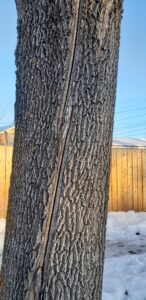
Image compliments of City of Camrose
Cause: Rapid temperature fluctuations between day and night.
“During periods of extreme weather when temperatures drop quickly, trunks and stems of trees can develop frost cracks. The outer wood and bark of the tree cool rapidly, which causes the shrinking and cracking. This can also happen when the moisture inside a tree freezes and expands, splitting the bark.” (Source: City Of Camrose)
Recovery Steps: Clean the affected area, trimming any loose or damaged bark. Apply a breathable tree wrap to protect against further cracks, and consider planting windbreaks to minimize temperature fluctuations.
According to the City of Camrose, “Once a tree has been injured in this way, the crack will re-open each winter in the same location on the tree. Over subsequent years the tree will develop callus tissue along the vertical frost cracks. Generally, frost cracks do not affect the stability of a tree and the cracks will close back up as the temperature climbs.”
Winter Burn:
Signs: Browning or desiccation of evergreen needles, typically on the side exposed to prevailing winds or sunlight.
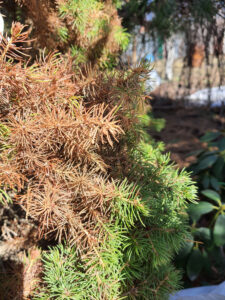
Cause: Loss of water through leaves during winter, especially when the ground is frozen and roots cannot absorb water.
Recovery Steps: Gently prune the affected areas, providing adequate watering during dry periods, and consider anti-desiccant sprays to protect against further moisture loss. Also, provide a little extra fertilizer and water during the growing season. Learn about our Tree & Shrub Deep Root Fertilizer here.
Branch Damage from Ice and Snow:
Signs: Broken or bent branches, often a result of heavy snow or ice accumulation.
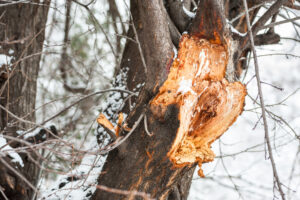
Cause: Excessive weight on branches due to snow or ice.
Recovery Steps: Carefully remove snow from branches to reduce weight. If a branch is broken, make a clean cut just outside the branch collar to promote proper healing.
Salt Damage:
Signs: Browning or scorched appearance on leaves and needles, especially on the side facing roadways treated with de-icing salts.
Cause: Exposure to de-icing salts used on roads and sidewalks.
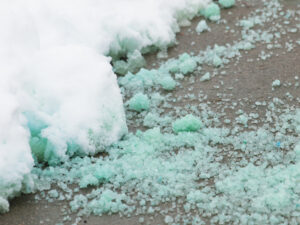
Recovery Steps: Water the soil thoroughly in early spring to flush out excess salts. Consider using alternative de-icing materials or protecting trees with physical barriers.
How to Address Winter Damage:
1. Assess the Extent of Damage:
Carefully inspect your trees for signs of winter damage. Look for cracked bark, discolored foliage, or broken branches. Assessing the extent of the damage will guide your recovery efforts.
2. Prune Carefully:
Gently prune damaged branches, making clean cuts to promote proper healing. Remove any broken or hanging branches that could pose a safety risk. Avoid heavy pruning during winter, as it may further stress the tree. Earth Smart Property Solutions offers light pruning and shaping and trim dead branches from trees and shrubs up to approximately 12′ in height. Learn more about this service here.
Please note that we are not arborists and simply offer shaping and clean up services of dead branches. If you are looking for a licensed arborist, we would be happy to provide recommendations.
3. Provide Adequate Water:
Winter dehydration is a common issue. Watering during dry periods when the ground is not frozen can help replenish moisture and mitigate winter burn.
4. Apply Mulch:
Mulching around the base of your trees helps regulate soil temperature, retain moisture, and protect roots from extreme temperature fluctuations. Apply a layer of mulch, keeping it away from the trunk to prevent rot.
5. Protect Against Future Damage:
Consider preventive measures such as wrapping susceptible tree trunks with burlap or applying tree wraps to minimize the risk of frost cracks. Planting windbreaks can also shield trees from harsh winter conditions.
6. Consult with a Professional:
If you’re unsure about the extent of winter damage or the appropriate course of action, consult with a certified arborist. They can provide expert guidance and recommend specific treatments tailored to your trees.
In conclusion, winter damage on trees is a common concern, but with proactive identification and appropriate recovery measures, you can help your trees thrive despite the challenges of the season. Observing your trees regularly and taking prompt action will contribute to their resilience and ensure a healthy canopy come spring.
If you have any questions about caring for your trees or lawn, please feel free to contact our team.
Sources:
City of Camrose, Frost Cracks in Trees


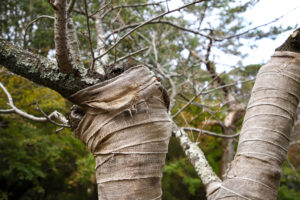
Recent Comments